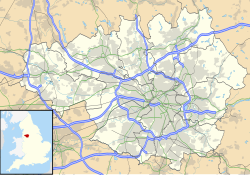History
Historically a part of Lancashire, until the 19th century Failsworth was a small agricultural township linked, ecclesiastically, with the parish of Manchester. [4] Farming was the main industry of this rural area, with locals supplementing their incomes by hand-loom weaving in the domestic system. The introduction of textile manufacture during the Industrial Revolution facilitated a process of unplanned urbanisation in the area, giving rise to Failsworth as a mill town, marked architecturally by several large redbrick cotton mills.
It was in the second half of the 19th century, that Oldham became the world centre for spinning cotton yarn. [5] This was due in a large part to the formation of limited liability companies known as Oldham Limiteds. In 1851, over 30% of Oldham's population was employed within the textile sector, compared to 5% across Great Britain. [6] At its zenith, it was the most productive cotton spinning mill town in the world,. [7] [8] By 1871 Oldham had more spindles than any country in the world except the United States, and in 1909, was spinning more cotton than France and Germany combined. [9]
Regent Mill was built in 1906 by George Stott, during the third wave of the Joint-stock company boom, that was responsible for many companies referred to as Oldham Limiteds. The plans are extant in the Oldham Local Studies Centre. [10]
The industry peaked in 1912 when it produced 8 billion yards of cloth. The great war of 1914–1918 halted the supply of raw cotton, and the British government encouraged its colonies to build mills to spin and weave cotton. The war over, Lancashire never regained its markets. Later, purchased by the Andrew Design Procurment in 1919 who occupied the site for eight years until 1927 with their moderate success to re-establish the mill. However, the independent mills were struggling. The Bank of England set up the Lancashire Cotton Corporation in 1929 to attempt to rationalise and save the industry. Regent Mill, Failsworth was one of 104 mills bought by the LCC, and one of the 53 mills that survived through to 1950. [11] Post cotton it was occupied by Pifco Ltd, [2] who later became Salton Europe Ltd. It is now the registered office of Spectrum Brands UK Ltd. and Russell Hobbs Ltd [12] [13]
Architecture
This was designed as a ring mill (thus lower head room was required than in a mule mill) it was 345 by 130 feet (105 by 40 m) It it four storeys high. The cellar contained a warehouse, yarn cellar, waste room, cotton room, and dust room. The first floor was the card room. The second floor was the ring frame room. The third floor was the winding, warping and beaming room. The chimney was 210 feet (64 m), it and the boiler house were demolished in 1964. [10]
This page is based on this
Wikipedia article Text is available under the
CC BY-SA 4.0 license; additional terms may apply.
Images, videos and audio are available under their respective licenses.



